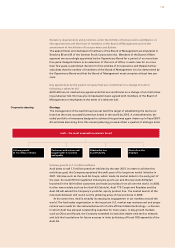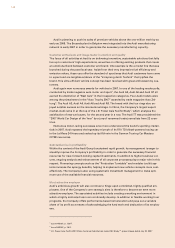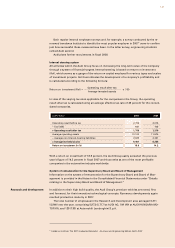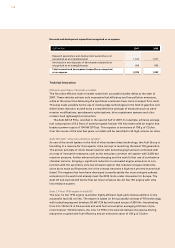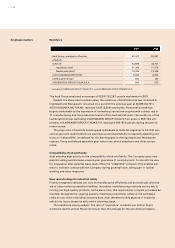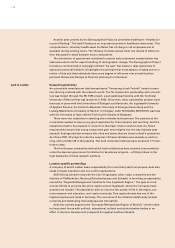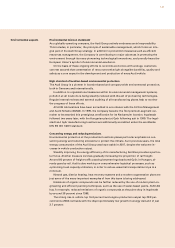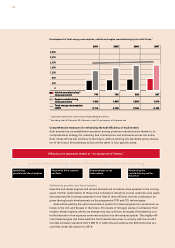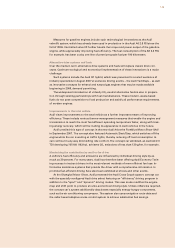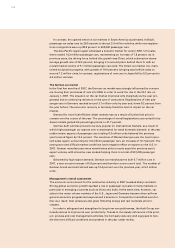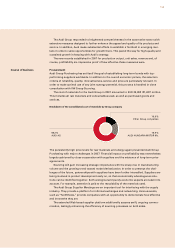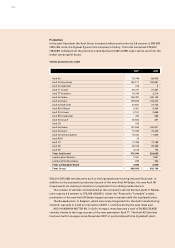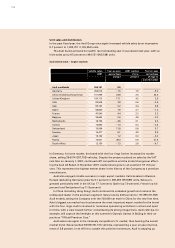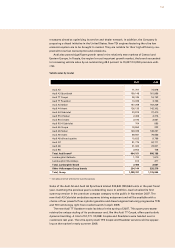Audi 2007 Annual Report Download - page 152
Download and view the complete annual report
Please find page 152 of the 2007 Audi annual report below. You can navigate through the pages in the report by either clicking on the pages listed below, or by using the keyword search tool below to find specific information within the annual report.
149
Measures for gasoline engines include such technological innovations as the Audi
valvelift system, which has already been used in production in the Audi A6 2.8 FSI since the
fall of 2006. Controlled valve lift further boosts the torque and power output of the gasoline
engine, while appreciably improving fuel efficiency. The fuel consumption of the A6 2.8 FSI,
for example, has been cut by one liter of premium-grade fuel per 100 kilometers.
Alternative drive systems and fuels
Over the medium term, alternative drive systems and fuels will replace classic drive con-
cepts. Optimum ecological and economical implementation of these innovations is a major
challenge.
Such systems include the Audi Q7 hybrid, which was presented to a select audience of
industry specialists in August 2007 at exclusive driving events – the Audi TechDays – as well
as innovative concepts for ethanol and natural gas engines that may be made available
beginning in 2009, demand permitting.
The widespread introduction of virtually CO2-neutral alternative fuels is also in prepara-
tion through existing partnerships with fuel manufacturers. These modern, waste-based
fuels do not pose competition to food production and satisfy all performance requirements
of modern engines.
Improvements to the total vehicle
Audi views improvements to the total vehicle as a further important means of improving
efficiency. These include various thermo-management measures that enable the engine and
transmission to reach the most fuel-efficient operating temperature faster, along with brak-
ing energy recovery, which will be making its appearance in Audi vehicles in the future.
Audi unveiled this type of concept in the new Audi A4 at the Frankfurt Motor Show (IAA)
in September 2007. The concept also featured Automatic Start/Stop, which switches off the
engine while the car is waiting at traffic lights, thereby reducing off-load consumption to
zero without in any way diminishing ride comfort. The concept car exhibited, an Audi A4 2.0
TDI developing 105 kW (143 hp), achieves CO2 emissions of less than 130 g/km, for example.
Maximizing the contribution by and for the driver
A vehicle’s fuel efficiency and emissions are influenced by individual driving style by as
much as 30 percent. For many years, Audi has therefore been offering Audi Economy Train-
ing courses to instruct drivers in the most relevant methods of more efficient fuel use. In-
formative assistance systems that provide the driver with comprehensive information to
promote fuel-efficient driving have also been exhibited at shows and other events.
At the Shanghai Motor Show, Audi presented the Audi Cross Coupé quattro concept car
with the specially configured Audi drive select featuring an “efficiency” driving program in
addition to the “sport” and “dynamic” driving modes. This new mode modifies the engine
map and shift point to produce an ultra-economical driving style. Unless otherwise required,
the concept car’s system additionally deactivates especially energy-hungry components,
such as the air conditioning compressor. The system also uses navigation route data and
the radar-based adaptive cruise control system to achieve substantial fuel savings.


